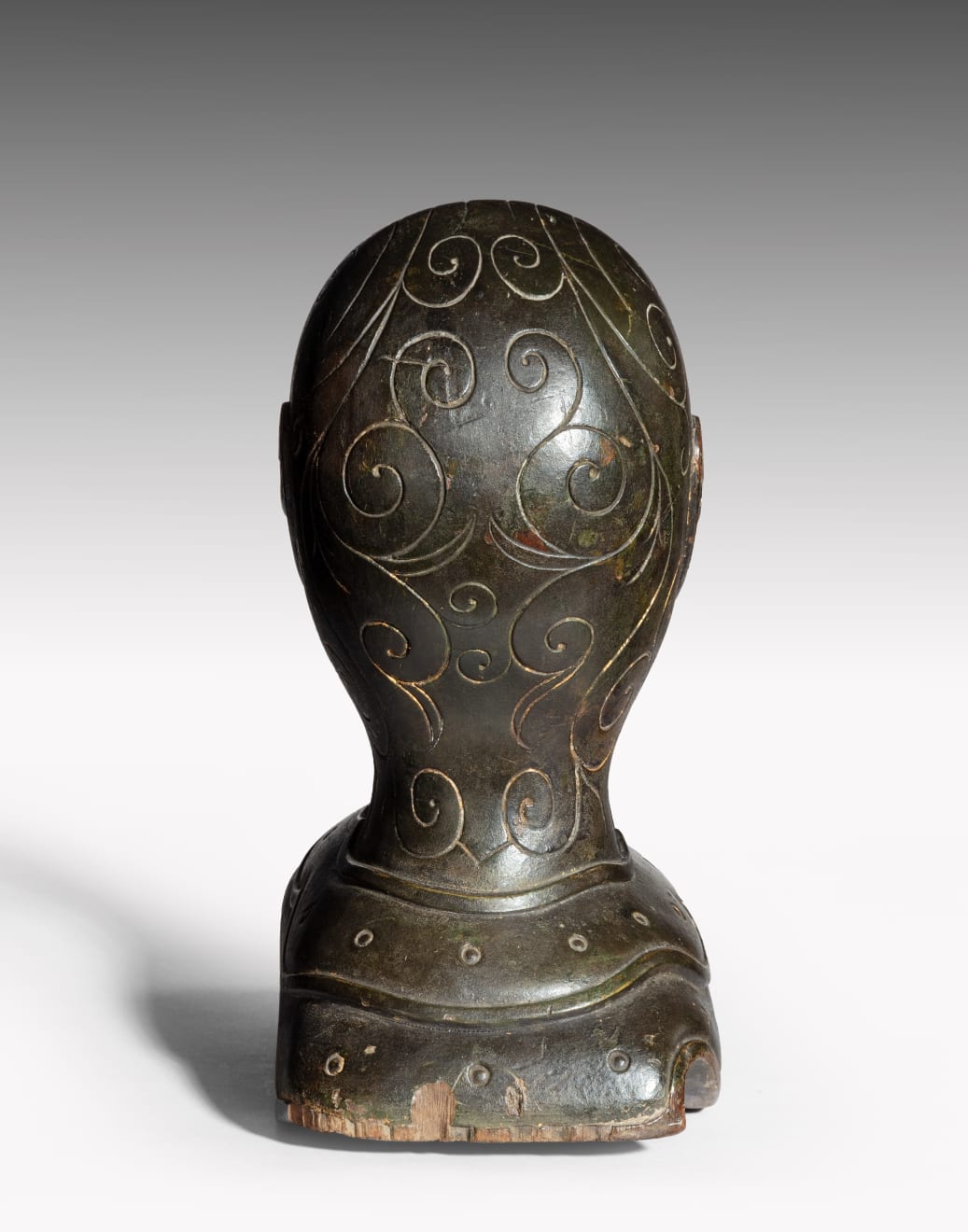Patinated Carved Wood Antiquarian Armet Attributed to George Bullock
ENGLAND, CIRCA 1800
35.6 x 17.1 x 27 cm
14 x 6 ¾ x 10 ¾ in
14 x 6 ¾ x 10 ¾ in
6858
Further images
Carved and painted as an armet with extensive scroll and foliate decoration, traces of gilding, the front of the shaped base raised on a wooden block. In the early 19th...
Carved and painted as an armet with extensive scroll and foliate decoration, traces of gilding, the front of the shaped base raised on a wooden block.
In the early 19th Century there was a fashion in some country houses to revive a baronial interior; adorning an armoury with displays of weapons on the walls. George Bullock was commissioned to produce suitable decorative armour which, as much of it was to be hung high on the wall, was produced from painted ceramic and carved pine. Bullock produced multiple pieces for the Entrance Hall at Cholmondley Castle in Cheshire, which Clive Wainwright illustrates and discusses in George Bullock: Cabinet-maker (London, 1988), showing the variety of decorative ‘armour’ adorning the walls. (Figs. 17 and 18, p. 57).
An armet was a type of visored helmet worn in the 15th and 16th centuries which completely enclosed the wearer’s head while being light enough to be worn (relatively) comfortably. The painted decoration on this armet has been closely compared with the decoration on Bullock’s shield produced for Cholmondley (see photo) and appears to be very similar.
George Bullock (1777/78-1818) was an influential sculptor, marble-mason and cabinet-maker who undertook a number of major furnishing commissions. He was trained by his mother, who exhibited wax models at 29 Bull Street, Birmingham between 1794 and 1798. Bullock worked in wax, rice-paste and plaster, and developed a reputation as a noteworthy artist.
In 1804, George Bullock was working in Liverpool: ‘Bullock, George, Modeller and Sculptor, Lord Street’ (‘Gore’s Directory for Liverpool and its Environs’, Liverpool, 1804) where he attracted a number of important patrons for his sculptural work, which he exhibited at the Royal Academy. By 1805 Bullock had entered into a partnership with a looking-glass maker called William Stoakes, advertising as: ‘Bullock & Stoakes Cabinet Makers, General Furnishers and Marble Workers 48 Church Street’ (‘Gore’s Directory for Liverpool and its Environs’, Liverpool, 1805). Their showrooms were named the ‘Grecian Rooms’, and were housed: ‘at Mr Stokes Looking Glass Manufactory … this day re-opened where are the most extensive collection of Bronze and Bronzed Figures … Marble Tables, Chimney Pieces … see the Rich Gothic Furniture, Armour &c which he has designed and executed for Lord Cholmondley’ (Liverpool Chronicle, 4 September 1805).
In the early 19th Century there was a fashion in some country houses to revive a baronial interior; adorning an armoury with displays of weapons on the walls. George Bullock was commissioned to produce suitable decorative armour which, as much of it was to be hung high on the wall, was produced from painted ceramic and carved pine. Bullock produced multiple pieces for the Entrance Hall at Cholmondley Castle in Cheshire, which Clive Wainwright illustrates and discusses in George Bullock: Cabinet-maker (London, 1988), showing the variety of decorative ‘armour’ adorning the walls. (Figs. 17 and 18, p. 57).
An armet was a type of visored helmet worn in the 15th and 16th centuries which completely enclosed the wearer’s head while being light enough to be worn (relatively) comfortably. The painted decoration on this armet has been closely compared with the decoration on Bullock’s shield produced for Cholmondley (see photo) and appears to be very similar.
George Bullock (1777/78-1818) was an influential sculptor, marble-mason and cabinet-maker who undertook a number of major furnishing commissions. He was trained by his mother, who exhibited wax models at 29 Bull Street, Birmingham between 1794 and 1798. Bullock worked in wax, rice-paste and plaster, and developed a reputation as a noteworthy artist.
In 1804, George Bullock was working in Liverpool: ‘Bullock, George, Modeller and Sculptor, Lord Street’ (‘Gore’s Directory for Liverpool and its Environs’, Liverpool, 1804) where he attracted a number of important patrons for his sculptural work, which he exhibited at the Royal Academy. By 1805 Bullock had entered into a partnership with a looking-glass maker called William Stoakes, advertising as: ‘Bullock & Stoakes Cabinet Makers, General Furnishers and Marble Workers 48 Church Street’ (‘Gore’s Directory for Liverpool and its Environs’, Liverpool, 1805). Their showrooms were named the ‘Grecian Rooms’, and were housed: ‘at Mr Stokes Looking Glass Manufactory … this day re-opened where are the most extensive collection of Bronze and Bronzed Figures … Marble Tables, Chimney Pieces … see the Rich Gothic Furniture, Armour &c which he has designed and executed for Lord Cholmondley’ (Liverpool Chronicle, 4 September 1805).














